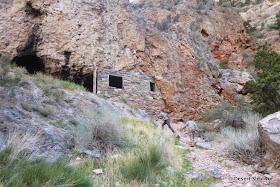There's a small shelter cave just below the real cave entrance that provides very nice views.
Then we reached the main entrance, with a bat-friendly gate. The entrance drop is about twenty feet. The boys decided they wanted to be lowered into the cave rather than rappelling in.
The adults all rappelled into the chamber, which opened up.
We soon faced choices. Down a little hole in the floor, or down a slope that turned into a climb? We had a map from the BLM, but it was at a small scale so hard to decipher. I knew one passage I particularly wanted to visit, so we headed that way. A lot of Antelope Springs Cave consists of a tube with domes and floors that suddenly drop off.
We found some wonderful colors in the rock and formation.
We also found a lot of tight spots. We had to try some. Here's Desert Boy going through one. A couple adults went through this little hole too. The cave is warm, but when you're belly crawling, it feels even warmer.
There's not a lot of graffiti in the cave, but some. We explained cave conservation to the boys and how it is really bad form (not to mention illegal) to spray paint or write on the walls. We also explained how the arrows usually show the way out of the cave. However, sometimes the people don't know the way out, like shown below.
We spent a fun few hours looking around. This is a challenging cave, with lots of climbing, steep dropp offs, and slippery slopes. At one point I even made a webbing harness and we belayed the boys with another piece of webbing. Eventually we decided it was time to go, particularly when we got to a very slippery spot with a long, steep slope. I wanted to have the boys tied in for that, but we didn't have enough extra webbing or rope with us. So we played it safe and headed back. There are a lot of potentially dangerous places in this cave where it would be easy to break a leg, so we went slow. And as you can see from the photos, we all had helmets, multiple lights, gloves, knee pads, and some even had elbow pads.
To get the boys out we used a traveling haul system. This is a haul system that moves with the patient, and although it's not as quick as a haul from the top, it could be useful in some situations. Plus it's good to practice those rescue skills regularly! For the first boy, we had the boy push up the upper ascender (a Pantin). He could only move it up about a foot at a time, so we had a lot of resets. For Desert Boy, we put a webbing leash on the Pantin that could be pulled from the top, and that worked really well. The only extra gear used besides the regular Frog system were two pulleys and a piece of webbing.
Although Desert Boy enjoyed his free ride up, we'll be doing some vertical training soon to get him ready for the climbing contests at the 2016 NSS Convention in Ely, Nevada.
The light of day is always a welcome sight after a satisfying cave trip.
After we refueled, we went to the public land near U-Dig Fossils and spent some time looking for trilobites. We didn't find many, but we did see a few, including very small ones.
Breaking rocks was a lot of fun.
Another stop on the way back was Hermit's Cave in Marjum Canyon.
We found some supplies there for the Apocalypse. The mice had found them too, unfortunately.
We also noticed some climbing bolts in the area--something we may have to return and try out.
One of our group got a flat tire, so we had to go slow. That let us get some spectacular views of Notch Peak, the highest limestone cliff in North America.
During the whole day I think we saw only one or two other vehicles. These are remote places!
















No comments:
Post a Comment
Hi, I love to read your comments! I've recently decided to turn off word verification to make it easier to leave comments, but in doing so, I'm only accepting registered users to avoid spam. You can also leave comments on the Desert Survivor Facebook page. Thanks!